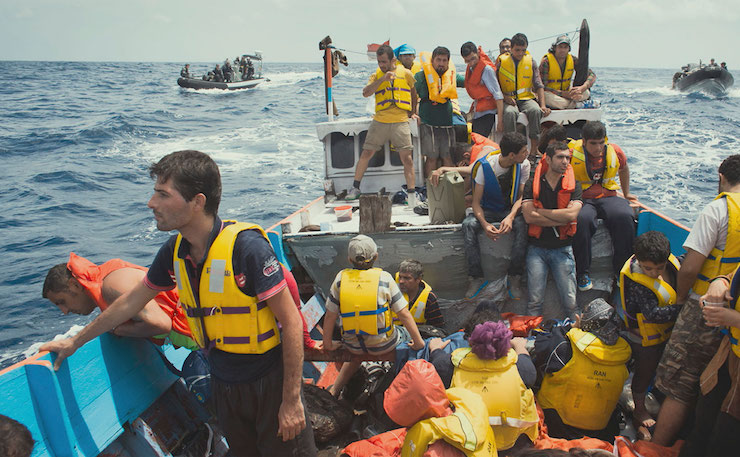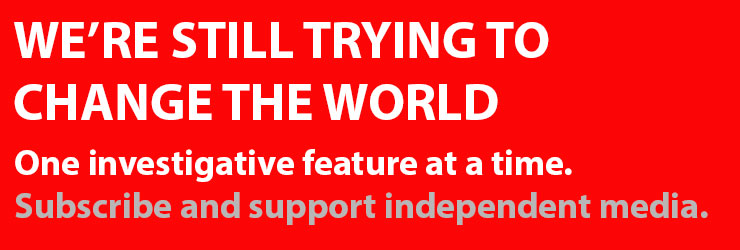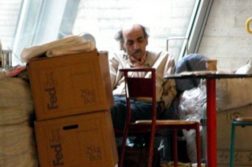The Turnbull government is once again targeting asylum seekers, this time those already living in the community. Michael Brull explains the unfolding situation.
Right now, the crisis faces some 1,200 asylum seekers in Australia. Increasingly desperate calls for help have been coming from the Refugee Advice and Casework Service (RACS). They are scrambling to help those 1,200 people.
But the scale of the crisis may be up to 10 times as large. Having stripped asylum seekers of procedural rights, funding for interpreters and legal assistance, the government is now threatening large-scale detention of asylum seekers in the community.
If the rights of perhaps 11,000 asylum seekers are to be protected, it will need massive public solidarity. They need donations, and they need public pressure, and they need it now.
The threat
To understand the situation, I spoke to RACS’ Acting Principal Solicitor Sarah Dale. I asked her to summarise the current situation. Sarah said:
“We have over 1,200 people on our waiting list, who are seeking assistance to apply for Temporary Protection Visas (TPVs) or Safe Haven Enterprise Visas, to apply for protection here in Australia.… These 1,200 people cannot afford private agents, they cannot afford private legal advice, and so they come to RACS to get the pro bono services that we offer to asylum seekers in the community. Previously we would provide the Department of Immigration notification that people are attempting to engage in the process of applying for protection here in Australia. And those people would be given additional time to wait for our services. The Department has issued a policy where they want applications processed quickly, and therefore, the opportunity to wait for legal advice or legal assistance is no longer afforded to these people.”
The problem now is this:
“Some people have been issued with letters that enforces a 60-day lodgement period. If they contact the Department [of Immigration and Border Protection], then they will be provided with an additional 30 days to lodge. If you don’t contact the department, or you miss this deadline, you will be suspended from any financial support that you’re currently receiving through SRSS [Status Resolution Support Services]. Once you’ve been suspended from SRSS – so once the 60 or 90 day time has passed – you then have an additional 14 days to lodge an application (or your preferred status resolution) which means that your bridging visa may not be reviewed, and you may face detention.”
The Guardian posted an online copy of one of those menacing letters from the Department of Immigration and Border Protection (DIBP). It warns a person who failed to lodge their application in that 60-day period that their payments “are now being ceased”. DIBP warned that it would consider “not granting you another bridging visa. This will mean that you will be an unlawful non-citizen. You will lose access to Medicare and permission to work in Australia”. It goes on to warn that, “If you do not apply for a TPV or a SHEV, you are not considered to be an asylum seeker and are expected to leave Australia. Departure assistance is available at…. If you do not make plans to depart Australia voluntarily we will approach the government of your country of nationality to arrange a travel document on your behalf.”
The crisis
So there are 1,200 asylum seekers, who have been told they have 60 days to lodge their application, though if they can get in touch with DIBP, they may get an extra 30 days. How is RACS equipped to face this influx of urgent cases?
It isn’t.
Sarah Dale says: “We have waiting lists for over 12 months at our centre, to try and meet the huge demand. And ultimately, our wait list will mean that people will miss out on assistance if they are to follow these lodgement deadlines as prescribed. They will miss the deadline.”
I asked Sarah if she had an idea of what proportion of the cases RACS would be able to work through. “That’s a good question, and I haven’t broken down the figures exactly. We see on average – probably 30-50 people a week. We have Clinic Saturdays – where we’re able to access approximately 60 clients in a day. But that takes into account taking their statement, that doesn’t take into account filling in the form, giving them advice about the process, ensuring that their applications are filled in fully and correctly. On average it’s probably at least a day’s work per person to have a completed application for protection.”
I tried to figure the maths out: “So if it’s on average a day’s work…”. Sarah interjected: “We need 1,200 days for one lawyer.” Me: “How many lawyers are there at RACS now?” Sarah: “At RACS on this project, we only have two staff.” Me: “There’s two staff on that?” “Yeah, on this project.”
Fuck. My words, not Sarah’s.
Sarah went on:
“The majority of our workforce for this project is from volunteer lawyers. And volunteer solicitors that are donating their time during the evenings, and on the weekend, to assist us to meet the demand of this cohort. But for every volunteer that we have, we also need to have an expert human rights lawyer to assess the application and ensure that it is accurate. So we do have a huge volume of volunteer support, which we’re so, so grateful for, but we still need solicitors on the ground here at RACS in order for us to meet that deadline, and at this stage, we don’t have the resources for that, and we don’t have the capacity to put on more lawyers to meet this deadline.”
Two lawyers seeing five clients a week equals ten per week. The deadline is 60 days, but let’s say that all of them somehow manage to get the 30-day extension. Let’s also round up 90 days to 13 weeks. At the current rate, Sarah guess-timated for me, RACS would help 130 asylum seekers lodge protection claims by the end of those three months. The rest would be on their own, trying to navigate and explain complex issues in a foreign language, without legal advice or even interpreters. Of 1,200, that would be some 1070 people the government would give no meaningful chance to present their case.
I said to Sarah that the influx was likely to grow. “Yeah, it’s very likely that there will be more, it’s very likely that many people have received these letters. We understand that there are about 10-11,000 people that still haven’t lodged their applications across Australia. And of that cohort, NSW and Victoria have the biggest asylum seeker communities. So, it’s inevitable that that 1,200 will probably grow,” Sarah said. “This is really a crisis,”.
I asked if RACS had a fundraiser to deal with this. They explained their emergency appeal on their facebook page, and donations are solicited here.
How asylum seekers were set up to fail
In 1997, the government of John Howard set up a process of legal aid for asylum seekers. That scheme lasted for 11 years under Howard, and through the three ALP governments of Kevin Rudd and Julia Gillard. In 2014, Tony Abbott almost entirely wiped it out.
Overnight, RACS lost 85 per cent of its funding. Sarah explained that the Coalition “implemented a new policy where only those that they determined as particularly vulnerable had access to that funded legal service. So it’s left approximately 85 per cent of asylum seekers without access to funded legal assistance”. Funding for interpreters was also slashed.
In 2012, the Government of Julia Gillard introduced a “no advantage” policy. It stopped processing asylum seeker claims, imposing a bar on the processing of claims. “For people who arrived from 13 August 2012, they’ve not been able to apply for their visa, because they required the minister to lift the bar and to invite them to lodge that application.”
In the meantime, the process of evaluating claims has changed dramatically. In 2014, the Coalition was also able to force a raft of bills through the Senate. Part of their success in doing so came from bullying cross bench senators like Ricky Muir from the Motoring Enthusiasts Party. They did so by using children as bargaining chips, warning that those children would be kept in detention unless the legislation was passed.
Among the many heinous innovations was the abolition of the Refugee Review Tribunal. It was replaced by a “fast track assessment” process for those who arrived after August 13, 2012.
RACS made a lengthy submission outlining the many problems with this process. It limits the rights of asylum seekers to “limited merits review” of adverse decisions. It has “deficient standards of procedural fairness that significantly and unjustifiably increase the likelihood of errors in decision-making”. And it gives “broad Ministerial power to exclude additional classes of people from merits review, without Parliamentary oversight”.
As asylum seekers who came by boat have generally high rates of success in applying for asylum, the government presumably hoped that the new process would be sufficiently slanted against asylum seekers to overcome the strength of their claims under a fairer process. Starved of funding for lawyers and interpreters, asylum seekers would now be forced to deal with a system where they would race against time in a system many of them would have no chance of understanding. Where their traumas require sensitivity and understanding, the government was doing its best to slam a cold hard door in their faces, immune to their pleas for help.
With the system reformed, the government lifted the bar. From 2015, invitations went out to asylum seekers to apply for protection visas. Sarah explained that “what’s happening now is that the Department is saying that people have had significant time to lodge their application, and therefore we’re putting in this very strict deadline, because assistance should have already been sought, people should have already had an application prepared.”
Sarah said that “for services such as RACS, we have waiting lists for over 12 months long. Which means that even if you access us, as soon as you got that letter, you could still be waiting for our assistance, because we have such an overwhelming demand from the community here in Sydney to assist them”. She estimated that there have been “approximately 24,000 people that have been invited to apply for protection visas since 2015.”
The process now
I asked Sarah to explain the fast track process. She said that under this new system,
“asylum seekers have the opportunity to apply by submitting a written form through the Department of Immigration, detailing their history, and detailing their claim, or the reason why they fled their home country, and the reason why they’re seeking protection here in Australia. Once that application form is lodged, that individual is then invited for an interview with the Department of Immigration. Now currently on average, interviews (are) lasting anywhere from an hour to two to three hours. So they’re quite short interviews under the fast track assessment process.”
It is important that asylum seekers present the best case that they can in their application and interview. Because if they, say, forget something important, or get mixed up about some facts, it could be fatal to their cause. Sarah explained that:
“Where a decision is made to not grant that applicant protection, their case is referred to the Immigration Assessment Authority (or the IAA). And at this stage, that IAA officer will just review the case as it was before the Department of Immigration. So there’s not an opportunity to put on additional information, unless there are reasonable or very significant reasons why one would do that. And also that person isn’t invited to a second interview. There’s no ability for the IAA officer to test credibility for themselves, or to interview that applicant for themselves. So really, the only chance a person has to advocate for their case or articulate their claim in a face-to-face interview is in that interview with the Department of Immigration. Previously, people that arrived by boat would have had access to the RRT (Refugee Review Tribunal), or now the AAT, where they would be invited to a new interview where the information and evidence would be tested on its own grounds and on its own merits. However, the IAA just reviews the case as it was before the department.”
Before, if an asylum seeker failed to make a persuasive case, for whatever reason, they could try to appeal the decision to the Refugee Review Tribunal. The RRT would go over the case in full, and give a chance for the asylum seeker to make their case in person. The IAA has limited that ability to reconsider a decision, by arbitrarily excluding evidence which may be relevant, important, and even decisive.
It should be stressed: the IAA is not giving asylum seekers a meaningful chance to be heard. The government has institutionalised a system and process designed not to let an asylum seeker understand the process and make the best case they can.
It is a process designed to be harsh, and difficult to navigate, and to throw up arbitrary roadblocks to make it hard for asylum seekers to explain their situations. With an enormous shortfall of funding for legal advice and interpreters, many are facing impossible odds.
How would you go in making a complicated appeal by yourself to a foreign government in a language you didn’t understand without the benefits of interpreters? Would you be sure that you conveyed every single important thing – including matters which may be extremely traumatic and personal – with Department officials seemingly determined to find ways to not trust you and exclude you from the country?
What happens next
Though I had been aware of the crisis from panicked social media posts, my interview with Sarah brought home to me how terrible the situation is. I wondered what the end game was. First, they seemed determined to lock up asylum seekers in the community. Then what? Would they be sent to Manus or Nauru? Sarah replied:
“No, so you can’t get sent offshore unless you’ve already been offshore. If you don’t lodge your application in time, then you have your financial payments suspended. If you don’t lodge your application within 14 days of that suspension, then you will be referred to what’s called status resolution, and your bridging visa may not be renewed. And if you don’t have a bridging visa, that means you’re unlawful in the community, and if you’re unlawful in the community, then you’re facing detention. There is further policy that we fear, that may look to remove a person’s chance from applying for protection, so removing that invitation to apply for a visa, on the basis of failing to have lodged an application for a particular period of time.”
I asked what would happen to someone in detention. If they got sent to Villawood, would they stay there forever unless they left Australia?
“If a person is re-detained, or if a Bridging Visa is not renewed, the only power to get a new bridging visa is if the Minister personally intervenes in your case and personally decides to issue you with a bridging visa. And that’s a non-compellable power, which means that if these people are already detained, they may be detained indefinitely, because there would be no power which would compel Immigration or would compel the Minister to grant them a Bridging visa, releasing them from detention. It would all be dependent on the Minster’s personal intervention.”
I asked Sarah how people were going at RACS. I know many of the staff there, as I conducted my Practical Legal Training there. Sarah said that, “I think that at the moment, everyone at RACS, our primary concern is our clients. We’ve seen an escalation of numbers of distressed clients contacting RACS. We’ve seen increased rates of self-harm. We’ve seen the mood of the community definitely shift to panic and distress.” As for the RACS team, they “continue to rise to every challenge, and their main goal is to serve the community, and to serve the people that we want to ensure have access to protection.”
I tried to push Sarah to comment on the political implications of what was happening. At one point, I said that her answer was more of a legal one than a political one. She laughed and said, “You know you’re not going to get a political answer out of me Michael.”
I put to Sarah that the trajectory of government policy seemed clear. To deal with the backlog, they slashed funding to lawyers and interpreters, and instituted a new process to make it harder to make their case, harder to have their case reconsidered, with less procedural fairness and more obstacles to presenting relevant evidence in their favour.
The point seemed to be to exclude asylum seekers from the community. Sarah didn’t exactly bite, but responded indirectly.
“Our experience of fast track was that the onus of being fast is on the client. The onus of being fast is on the advocate for that client. But otherwise, the process in and of itself has not been particularly fast. There’s still long waiting lists when you’ve lodged an application before your interview.”
“Ultimately, we’re going to see a system where people’s claims may not be adequately assessed, because they have not been able to articulate them as they would if they had someone there supporting them and explaining to them what the process is and what it is that you need to put, what it is that you need to articulate as to their story and as to the key elements as to why they are here.”
The need for solidarity
Let me say it again. There is a crisis. Right now it faces some 1,200 asylum seekers. It may hit something like 11,000 asylum seekers. Their support payments may be cut, along with work rights and Medicare access. And then they may be thrown into detention indefinitely, without any legal recourse to have them released.
The desperately unfair process the government is imposing – rushed, without interpreters or legal assistance – may be the final chance many thousands of asylum seekers get to explain why they have sought asylum in Australia. They may never get a chance to get a fair hearing, to tell their story in any meaningful way.
If the government gets its’ way, many asylum seekers will effectively be silenced. People fleeing terror and oppressive governments will never get to explain why they fled their homes. They will be forced to choose between indefinite detention and being sent back to face the horrors they escaped.
It is up to us to decide what happens next. In the short term, those who can afford it can donate to RACS, and other legal centres scrambling to meet the demand.
The whole process is appalling. From the lack of funding to interpreters and lawyers, to the letters that may be sent to another 11,000 people, the government is threatening to widely expand its cruelty to asylum seekers in Australia.
Whether or not they can get away with it is a political question. The answer will depend on the rest of us.
Donate To New Matilda
New Matilda is a small, independent media outlet. We survive through reader contributions, and never losing a lawsuit. If you got something from this article, giving something back helps us to continue speaking truth to power. Every little bit counts.





